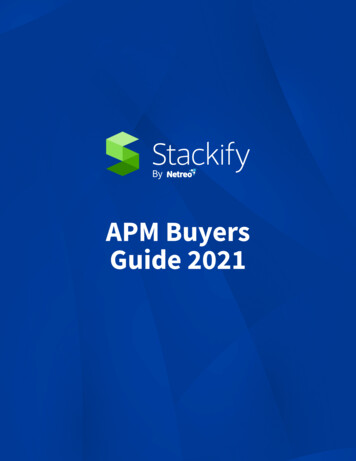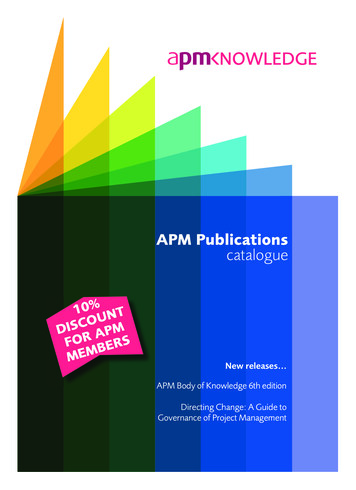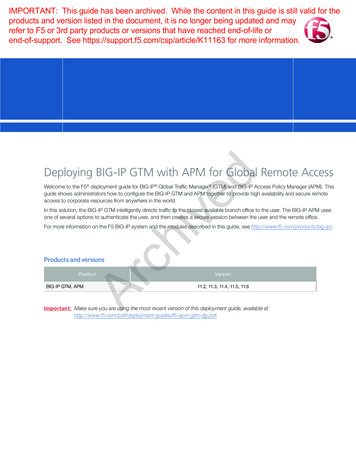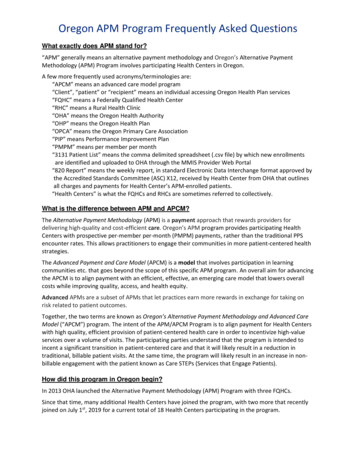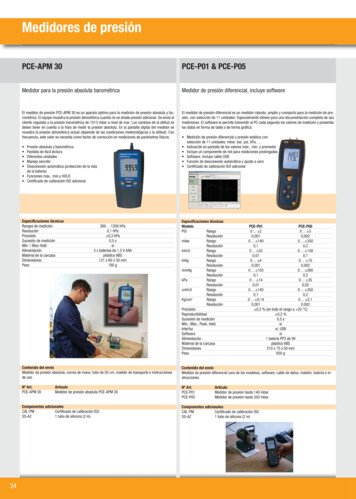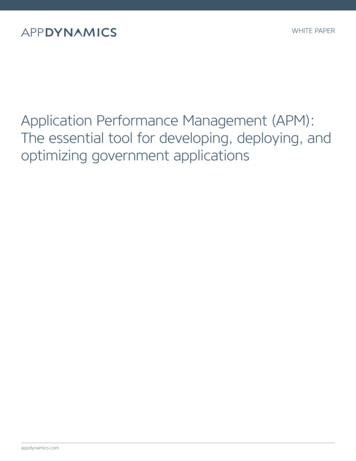
Transcription
WHITE PAPERApplication Performance Management (APM):The essential tool for developing, deploying, andoptimizing government applicationsappdynamics.com
The challenge of digital governmentThe role of information technology in government is rapidly changing. Until recently, IT has primarily served as a supportingcast member by providing the federal workforce with communications, office support, and back-end management systems.But in today’s emerging app-centric economy, the end user has become the key focus of companies and governments alike.Consequently, IT is fast becoming a primary means of executing the government’s vast array of missions, including deliveringvital intelligence to warfighters, delivering medical care to veterans, processing visa applications, assisting taxpayers, issuingweather alerts, conducting postal commerce, or dispensing disaster recovery assistance. In short, interactions between thegovernment and its citizens and constituents are occurring on countless smart phones, tablets, laptops, desktops, and back-endinterconnected systems.This sea change was anticipated in the White House’s 2012 Digital Government Strategy, Building a 21st Century Platform toBetter Serve the American People. “Today’s amazing mix of cloud computing, ever-smarter mobile devices, and collaborationtools is changing the consumer landscape and bleeding into government as both an opportunity and a challenge,” the DigitalGovernment Strategy says. “New expectations require the Federal Government to be ready to deliver and receive digitalinformation and services anytime, anywhere and on any device.” Federal agencies are increasingly running on complex apps and,consequently, mission success is increasingly reliant on well-designed and executed software applications.This new digital environment — enabled by cloud technologies, data center consolidations, virtualization, mobile technologies,agile development, and other aspects of IT modernization — also creates difficult challenges. Many agencies struggle tomanage and optimize the growing number of interdependent mission-critical applications within their infrastructure. That’sbecause traditional approaches used by agencies to monitor, measure, and improve IT performance must be rethought in orderto keep pace with today’s complex dynamic architectures. Most monitoring capabilities focus on individual silos within the ITinfrastructure — for example, databases, networks, servers, operating systems, etc. — and not on an app user’s journey fromstart to finish. Similarly, they do not effectively measure how an application’s performance impacts overall mission success.This means federal program managers and mission executives lack the required insight into why their applications may beunder-performing or how they could optimize them to achieve better mission results. Moreover, they lack the ability to adaptand optimize their applications to more complex, distributed, and dynamic environments, such as cloud, shared services orconsolidated data center environments.For IT operations staffs, the result is a poor understanding of the user experience. Citizens, federal employees, and other usersmay struggle for days with an underperforming application, but the operations staff may not find out until the complaints startrolling in. And once a problem is discovered, it may take hours to pinpoint the root cause and fix it, often at great cost in termsof wasted staff time and tax dollars that have been redirected from the core mission.For application development teams, silo-based monitoring approaches can hamper the effectiveness of any efforts to embraceAgile development and a DevOps culture, which are predicated upon a tight working relationship and shared responsibilitiesbetween development and operations teams. Developers rely on robust information exchange from the Ops teams to understandhow applications in production are behaving so they can optimize specific performance features and handle bugs within thesoftware as they iterate rapidly. With this shortened development cycle, they face critical blind spots if Ops teams can monitorapplication performance only through the fragmented reports they receive on each silo of the IT infrastructure.Optimizing application performanceFederal agencies can overcome the challenges of today’s application-centric environment with a capability called ApplicationPerformance Management (APM). APM solutions extract, collect, and analyze a wide variety of software signals, events, andmetrics surrounding an application and its supporting IT infrastructure, providing keen insights for improving operationalefficiencies and user experience.appdynamics.com2
How does it work? APM solutions instrument code, both on the back-end components as well as the front-end user browsersand devices, and can be deployed to present a complete and real-time view of how an application is responding to each user’sinteraction and how that application’s surrounding IT infrastructure is responding to that application. That data is conveyedgraphically on an interactive dashboard that an IT operator can use to manage the infrastructure, identify issues, and passrelevant depth to additional teams, including Development, QA/Test, 3rd party providers, and service providers. At the sametime, some APM solutions establish baselines of normal behaviors for application components and their interactions within theIT environment. Once baselines are established, a robust and effective APM platform will monitor a wide array of performancemetrics and conduct these most essential functions on a continual basis:–Count the number of application transactions at all times — peak and off-peak — to assess throughput performance.–Measure response times and errors of those transactions to gauge performance as experienced by the end user.–Compare the data against automatically established baselines to understand immediately if there are problems — abnormalbehavior — needing attention.–Alert the operations team when abnormal behavior is detected and provides contextual data to expedite the remedy.Figure 1 End-User Experience Monitoring: APM shows the response times and errors that end users throughout the world are seeingon their devices.appdynamics.com3
A mature APM solution enables organizations to quickly spot and fix performance problems, often before they prompt end-usercomplaints. This is accomplished with interactive dashboards provided by some APM solutions to determine where the problemresides. APM solutions, for example, can spot anomalies in the application code or within the application server, the host operatingsystem and databases. But if a problem exists in another silo, such as infrastructure, the specialists on those teams employ silobased monitoring and management tools to find the root cause of the problem. This ability to monitor code at such depth andbreadth so as to identify and fix problems at the application layer or within the IT environment, whether that code is your own ora third party’s, is what separates APM from tools that only monitor. Organizations should look for APM solutions that can do all ofthis regardless of the language the transactions are being conducted in, whether Java, Node.js, .NET, PHP or Python.In addition, a robust APM solution can map out the path of every transaction as it traverses the distributed applicationcomponents, including servers, databases, caches, queues, and third-party services. Having a clear picture of this path helps ITteams more efficiently configure their applications and IT environments for optimal performance.APM: The key to digital governmentAPM enables federal organizations to overcome the challenges of digital government and, equally important, seize itstransformative opportunities. These opportunities include:Deploying digital servicesThree key federal constituencies that stand to gain the most from APM’s capabilities are IT operators, developers, and programmanagers — the key players responsible for defining, developing, and deploying mission-focused applications.Program managers define the mission requirements and metrics for success, which developers then use to build applications. ITOps teams release those apps to production where IT operations teams maintain and troubleshoot them when things go wrong.Ops teams also provide dashboards, reports, and other performance feedback to the program managers to help them assess theapplication’s impact on the broader mission.Throughout this cycle, some of today’s APM solutions can track and analyze application performance data and presentit efficiently and simply to all stakeholders, without the need for expert assistance. This capability empowers all threeconstituencies for success.APM EMPOWERS THE ENTIRE AGENCYAPM delivers operational and mission value to:Program ManagersIT Development Teams– Better mission effectiveness due to higher-performingapplications and improved evidence-based decision-making tomanage application performance– Faster, more efficient, and higher-quality custom appdevelopment and deployment resulting from keener insightsinto an application’s performance and interactions within its ITenvironment– Less risk, greater visibility, and improved application performancewith cloud migrations, data center consolidations, mobiledeployments, and shared services environments– More successful citizen engagements– Greater insight into how applications are addressing missionrequirements– Reduced “reputational” risk associated with the failure of highprofile applications– Reduced need for help desk support– Better analytics to understand how multiple releases compare toeach other– Quicker root cause analysis, which is especially useful in agiledevelopment environments– Less time spent on troubleshooting problems in productionIT Operations Teams– Higher user satisfaction due to faster MTTR– Increased efficiency of IT ops staff resources, allowing moreresources to address emerging issues before they impact mission– A more efficient IT infrastructure due to increased visibility intowhere inefficiencies existappdynamics.com4
Fixing performance problems, fast!Most enterprises rely on silo-based monitoring tools to inform them of the health and availability of their infrastructurecomponents, such as networks, databases, servers, and storage arrays. While this approach works well for understanding theperformance of specific components, it is poorly suited to tracking the entire transactional flow of an application across allcomponents. Consequently, when an application is failing or responding slowly or with errors, an application-focused monitoringapproach that can view performance metrics across all silos along the application’s transactional path is best suited to quicklyidentifying where problems exists. Once the source of a problem is identified, then APM diagnostics can often identify the rootcause or else silo-based tools can be used to further correct the issues.This ability means that APM can dramatically cut the time and resources needed to fix a problem — known as mean time toresolution, or MTTR. This is especially crucial for time-sensitive or mission-sensitive applications that operate in highly distributedand complex IT infrastructures with many variables at play.Some APM solutions alert IT staffs when and where performance issues occur via email, text or an event open ticket on anIT Service Management platform. By dramatically speeding up MTTR, APM can minimize the impact of a poor-performingapplication on the end user, whether it’s a citizen applying for a benefit, a veteran awaiting instructions for care, a logisticianprocessing a part delivery in a combat zone, or a flood victim seeking assistance. Reducing MTTR translates directly intoimproved mission success, cost avoidance, and more staff time focused on the mission instead of on troubleshooting.Migrating to the cloud and other new environmentsMigrating IT infrastructure and applications to new environments, such as private or public cloud, consolidated data centers, andshared service centers carries inherent risk. For example, many federal executives worry that critical applications and capabilitieswill degrade in the course of a cloud migration. APM helps mitigate that risk by providing application owners with completevisibility into end-user experience.Facilitating a healthy DevOps cultureAPM helps development and operations teams get on the same page, which is critical for federal organizations striving totransform their IT staffs into fast-paced, agile, mission-focused organizations. One challenge is that development and operationsteams typically speak different languages. Developers typically converse in code, while operators focus on infrastructure metricssuch as availability, capacity, and response metrics. Log data is used across both teams, which is often the stepping-off point forbasic application visibility. APM’s focus on measuring and analyzing application performance at the user and transaction levelprovides a common bridge of communications for the development and operations teams, helping them integrate and work in amore agile method, being able to respond to changes in the requirements as they incrementally improve application functionality.ConclusionAs federal agencies move to modernize their IT environments and achieve the promise of digital government, digital applicationsare emerging as the modern-day workhorses of federal mission delivery. But application-centric operations and services alsorequire enhanced capabilities to develop, deploy, and manage applications in increasingly complex IT environments. Without theability to efficiently monitor and manage application performance, agencies cannot ensure the swift and effective delivery ofinformation and services to the citizens, federal employees, and warfighters who depend on those applications. The business ofgovernment will slow and grow more costly, and overall mission performance will suffer.APM helps agencies overcome these challenges by providing program executives and their IT teams with far greater levels ofvisibility and insight into how their applications are performing. APM tracks and analyzes the performance of all applicationsand transactions, helping agencies quickly uncover and fix problems with both their applications and infrastructure. With APM,agencies can move more confidently to public and private clouds, shared services, and other new environments. And they candeliver on the vision of a digital government that supports a vast array of users with optimized, mission-focused applications andservices, anytime, anywhere, and on any device.appdynamics.com5
About AppDynamicsAppDynamics is a recognized leader in APM, with a solid customer base across all three segments of government: Defense,civilian and intelligence. The AppDynamics Application Intelligence Platform is a comprehensive solution enabling governmentorganizations to maximize application and mission performance. The platform is designed and architected to give users theconfidence that their organization is running at its best, to give IT teams the operational visibility and control they need, andto give end users the great experiences they’ve come to expect and demand. The Application Intelligence Platform also isintegrated so as to provide monitoring data on all aspects of the application infrastructure, including the end users (nativemobile apps and browsers), databases, and servers.Independent research firm Gartner rated AppDynamics as No. 1 in “Completeness of Vision” in Gartner’s 2014 Magic Quadrantfor APM. Of 12 APM companies evaluated by Gartner, AppDynamics was one of only three given the top rating as an industryleader. Gartner noted that the AppDynamics platform is “easy to deploy and expand” and “AppDynamics products are identicalwhen deployed on-premises or SaaS, providing usability continuity. There is strong adoption for both models.”AppDynamics is also rated high in customer satisfaction. The company has a Net Promoter Score of 87, significantly higher thanthe software industry average of 17. The Net Promoter metric has become the industry standard for measuring customer loyalty,and AppDynamics’ score far exceeds even those of customer-centric companies like Apple and Amazon.Among its differentiating capabilities, AppDynamics offers:– Ease of deployment, whether on-premises, in the cloud, or in a hybrid environment– Deep and wide visibility into all transactions– Low overhead — less than 2 percent — in terms of storage and processing demands– Real-time analysis and management– Scalability to highly complex, distributed production environments– Baselining behaviors and assessing performance against those baselines– Presenting an integrated view of real-time user experience, application performance and infrastructure capacityFor more information about AppDynamics and its products, call 1-415-442-8400 or email info@appdynamics.com.Try it FREE at appdynamics.comappdynamics.com6
application performance only through the fragmented reports they receive on each silo of the IT infrastructure. Optimizing application performance Federal agencies can overcome the challenges of today's application-centric environment with a capability called Application Performance Management (APM).


